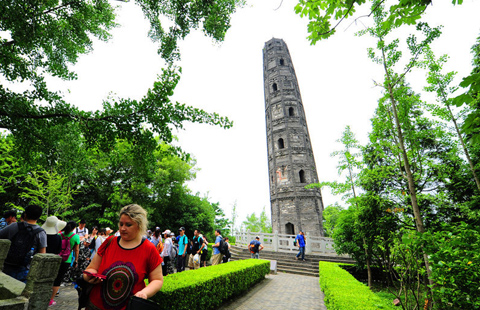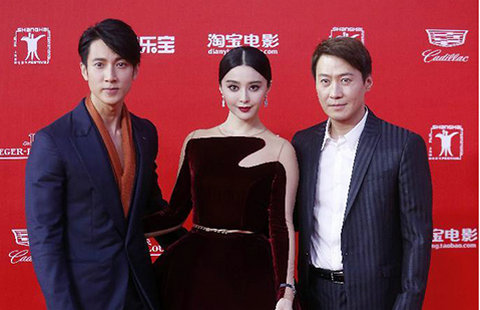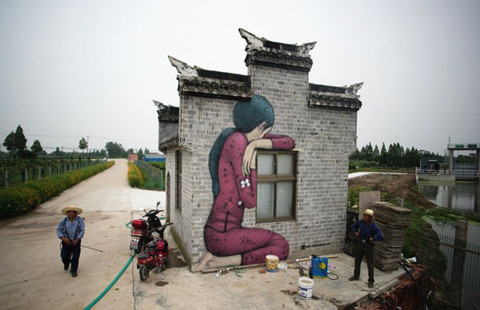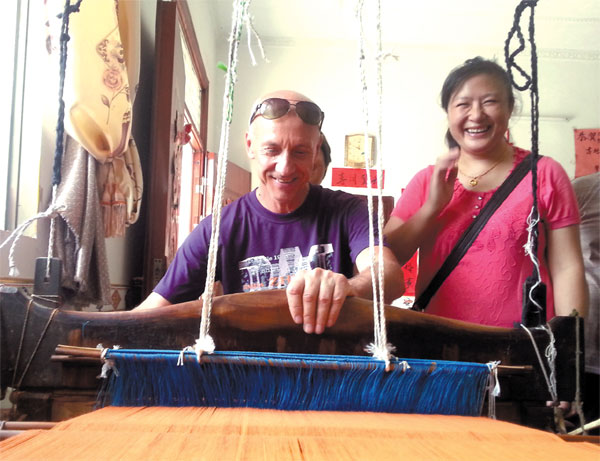A Russian teaches fashion in China
Updated: 2015-06-15 14:44
By Yang Yang(China Daily USA)
|
|||||||||
Clothing trends fascinate designer as tradition meets evolution
One of the things Victor Kuzmichev loves to do in his free time is to stroll along Hanzheng Street in Wuhan, Hubei province, the largest market in Central China.
The 60-year-old professor of Wuhan Textile University is keen to observe people in the market, and occasionally take their photos, which could later appear in some Russian textile and fashion journals.
"In the street, it's amazing to see how fast fashion spreads. For example, you'd see some design at the Paris Fashion Week, and one month later, you can see exactly the same design in the street, "he says, adding that "sometimes, you cannot tell which season the design belongs to, this year or last year."
Kuzmichev said weather is a factor that affects the spreading of fashion. In South China, it is warm almost throughout the year, so there is no need to wait for the fashion season to change. But in Russia and Europe, people have to wait.
For a scientist in the field of clothing, observing fashion in the streets can be a fun activity.
"I took photos of street styles. Some people look really good and their styles are unusual, so I would shoot them and publish the photos in journals. There are a lot of young people in Wuhan and they are very fashionable," he says.
Another of Kuzmichev's favorite hunting ground is the campus of Wuhan Textile University (WTU), where he has been teaching for the last 13 years.
Back in October 2002, when he took a bus from central Wuhan, arriving at the campus in Nanhu area, there were fields only.
"Sometimes, I would take a walk and there would be nobody around. Now it's hard to imagine the surroundings at that time. It has changed so much," the professor says.
In tandem with the transformation that has taken place in the Nanhu area in the past 13 years, the school of fashion in WTU has also taken big steps forward, with the help of this member of the Russian Academy of Sciences.
As the head of Garment Design Department at Ivanovsky State Polytechnic University in Russia, Kuzmichev helped to establish postgraduate education for the school of fashion in WTU with his experience there. The number of postgraduate students has risen from seven in 2004 to more than 100 today.
Cheng Zhe, 26, is going to graduate with a master's degree under the supervision of Kuzmichev. He says that after lectures, the professor will get students to his office one at a time to discuss academic questions, not only during the day, but also in the evening. Kuzmichev's students describe him as very strict, but a learned teacher and scientist. He starts work at 6 in the morning. He has supervised six PhD candidates so far.
"When we hang an exhibition board on the wall, we usually just judge whether it's slanted with our eyes, but he always uses a ruler, " Cheng says.
Kuzmichev is credited with starting new directions of clothing science and engineering at the university.
The history of pattern block making is very short in China. Pattern making is the key to clothes making, because it decides whether the clothes will fit or not. Generally, Chinese designers employ Japanese designers' method in pattern making because the two peoples are similar in body type.
"It's a very simple method. If China produces clothes only for domestic consumers, it will be enough, but it's not the case. If your pattern making is bad and the clothes don't fit, nobody will buy them," Kuzmichev says.
"So one of my jobs here at the beginning was to improve basic pattern making, to create new methods for pattern block making, taking inspiration from images of the human body," he says.
Besides the improvement of pattern block making, Kuzmichev and his students have also been looking for methods to make comfortable clothes with a human-body scanner.
"With my master students, we create a new classification of Chinese women's body types," he said.
"For example, full body bust. In pattern making, there is the size 84 according to the existing classification, but some women have a bigger chest and some have a bigger back, which have a strong influence on the comfort level and fitness of the clothes. So we try to improve the classification of Chinese body types," he points out.
Kuzmichev and his team use a body scanner to describe more exactly body shapes and pattern blocks.
The body scanner can create the image of a body and make clothes directly according to it, he says.
"I think this direction is very important because it's a high-level one that involves knowledge of the human body, pattern making and fashion design. It's a very wide direction, allowing me to recruit students from different educational backgrounds, such as fashion design, pattern making and computer science and engineering," he says.
Zhang Ni, 30, one of Kuzmichev's doctoral candidates, is now teaching at WTU. She is a member of his team.
"When we put on clothes, the body will have a kind of outline, which is different from the outline of the body itself. There is an inner space between the body and the clothes we wear, and the body and clothes will influence each other. We try to research this inner space and the mutual influence, which is a very different way from traditional ones," she says.
The university just acquired a new body scanner from Germany and installed it in Kuzmichev's office on the fifth ground of the building. On the fourth floor, the professor has another studio to direct students to combine traditional Chinese craftsmanship with modern fashion design.
On the ground floor of the building, there is a series of museums displaying not only the latest scientific achievements at WTU, but also the intangible culture heritage-traditional craftsmanship in Hubei province, including Han Embroidery and Hongan Large Cloth, and also the combination of this traditional craftsmanship with modern design.
"It's vital to save Chinese traditional culture. A nation has no future if it loses its tradition," as Kuzmichev puts it.
When Kuzmichev first arrived at the university, he was surprised to find that at a textile university, there was no museum to present Chinese traditional craftsmanship related to textiles.
At his suggestion, Ye Hongguang, another PhD student of his, established these museums step by step, and now he is the leader of the mission in Hubei province, to save the traditional textile culture.
Kuzmichev also noticed how fast China is being urbanized.
"Many people who originally lived in the countryside have moved to the cities, and it's impossible to save tradition in cities. Now the Chinese government is supporting the inheritors of traditional craftsmanship to continue with the skills in the countryside," he says.
The professor emphasizes that it is very easy to apply tradition in modern fashion.
"If you understand ethnic costume and the feeling of it, you can inject this feeling into modern design," he says.
He points at Zhang Ni, who is wearing a blue shirt and of white vest, saying that the match of the colors is borrowed from China's blue and white porcelain.
"You can see designers in each season's fashion week in Europe apply tradition in their design, and in their own ways. China must save its tradition because it does not only belong to China but to the world. Now we don't know how to use these traditional elements, but maybe in five or 10 years, people will use them in fashion because nobody knows which culture will influence global trends.
"I think Chinese tradition and culture will definitely influence the world because your traditional skills are formed after generations of use," he says.
In daily work, the professor encourages his team to apply tradition in modern design.
One day, Ye Hongguang, now a professor at the university's school of fashion, hung a costume of the Bai ethnic group in his office. There was a decoration made of a strip of cloth sewn on the costume. Seeing this decoration, Kuzmichev said to Ye that "it was so fashionable. It's just the global trend of three-dimensional design, very nice."
"He said students can apply this in their design, and if you went to Europe for a design contest, this Chinese element would be a shining point," Ye says.
In mid May, under the supervision of Zhang Ni and Kuzmichev, students from WTU won a silver award when they participated in a design contest in Russia.
The silver award winners applied Chinese elements in the design, attracting a lot of attention in Russia.
"We employed the shape of the Chinese window with the character fu (luck) stuck on it. We improved the original textile by using two materials together to create a different feeling, just like the silhouette on the window when sunlight shines through it. We also used the latest technique of lasers in creating the design," Zhang Ni says.
In order to help the craftspeople in the countryside better understand modern aesthetics and design, the WTU organized training classes for them. They are usually 40-to 50-year-old women.
Kuzmichev gave his professional suggestion on how to make the traditional cloth more comfortable, how to dye fabric and how to match colors for the products to meet modern people's taste. To better understand those crafts, he went to villages to see how the local people produce the cloth and embroidery.
In May, Kuzmichev was invited to meet President Xi Jinping in Moscow, where the Chinese leader attended the 70th anniversary celebrations of the WWII victory. Kuzmichev received the special gold medal for Sino-Russia friendship due to his contribution to the development of China's clothing science, fashion design and education.
"It was a great moment of my life. I felt great," he says.
|
Victor Kuzmichev tries a traditional loom at a village home in Dawu county, Hubei province. Photo Provided To China Daily |
(China Daily USA 06/15/2015 page10)
- Indian practioners to celebrate World Yoga Day
- Indonesia volcano unleashes fresh burst
- DPRK fires 3 short-range missiles into eastern waters: Yonhap
- China, S. Korea pledge to lift strategic cooperative partnership to new high
- WHO advises S.Korea to ban all MERS suspects' overseas travel
- New cargo train service between China, Europe opens

 Warriors move within one win of NBA title
Warriors move within one win of NBA title
 Ten photos you don't wanna miss - weekend special
Ten photos you don't wanna miss - weekend special
 Shanghai's leaning pagoda beats the Leaning Tower of Pisa
Shanghai's leaning pagoda beats the Leaning Tower of Pisa
 Top 10 luxury houses in the world
Top 10 luxury houses in the world
 18th Shanghai Int'l Film Festival kicks off
18th Shanghai Int'l Film Festival kicks off
 Dancing grannies' costumes are a stunning surprise
Dancing grannies' costumes are a stunning surprise
 Bubble Run brings fun to Shenyang
Bubble Run brings fun to Shenyang
 French street artist finds inspiration in Shanghai village
French street artist finds inspiration in Shanghai village
Most Viewed
Editor's Picks

|

|

|

|

|

|
Today's Top News
China, US sign agreement to boost army cooperation
Alibaba to launch Netflix-like video streaming service
Spacecraft that landed on comet finally wakes up
Former Chinese top legislator Qiao Shi dies in Beijing at age 91
China has adequate fiscal space to absorb local govt debt risks
US defense chief invited to visit China this year
Hillary Clinton makes pitch to working Americans at big rally
Six state firms checked in graft battle
US Weekly

|

|








